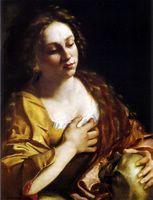
Artemesia Gentileschi's Penitent Magdalene
My senior project on the traditions of Mary Magdalene surfaces in my mind often. My morning coffee is sending me down a worm-hole to the research I did for that project. I am currently brainstorming my possible MA Thesis topics and my work with Mary Magdalene keeps surfacing in terms of women in the church -- their image, traditional roles, art, and models in scripture. Mary-Maggie represents nearly all the angst of women and Christianity to me--was she an independent wealthy woman who financed Jesus' mission or a prostitute barely saved by Jesus who worshipped him hungrily all her days afterward? Was she the one who poured oil on Jesus and wiped his feet with her hair (giving her the traditional alabaster jar prop) or was that just the nameless woman as scripture says? As a church, as a society, we struggle to let women exist apart from the men in their lives. We struggle to comprehend that Mary Magdalene may have come to Jesus because of his healing work, decided to support him with her means, and become his disciple. It seems much more familiar and comfortable to relegate her to what she "really" is -- a sexual deviant, a this-far-from-total-destruction dependent.
At a discussion of the Da Vinci code several months ago at church, we discussed the ideas present in the book regarding the relationship between Mary Magdalene and Jesus. Though most were comfortable releasing the ideas as "sensational," one gentlemen thoughtfully remarked, "Why would Jesus choose a prostitute?" I wanted so much to take over the discussion then, to break out all the scriptures directly and indirectly linked to Mary Magdalene and explore how Mary Magdalene is a symbol for much of the way the church and society relates to and thinks about women, and how her presence in our tradition can open us to the possibilities of both men and women in the church. Instead, I laughed at the assumption that she was a prostitute, and we went on.
My commitment to the symbol of Mary Magdalene continues. I appreciate the work of Elaine Pagels and others of our era who are returning to Mary Magdalene as a character of importance, deconstructing the sexualized images of her from the Middle Ages, and re-posing the question: who does the Bible say Mary Magdalene was? Who has history said she was? What are the discrepancies? What do these discrepancies reveal about how we think of women? Why is this helpful?


